 Image search results - "samurai" Image search results - "samurai" |

Statue of castle founder and 1st lord, Yuki Hideyasu 結城秀康
|
|

Shimizu Bank's relief of Kazutoyo and Chiyo
|
|

Demonstration of matchlock guns, Azuchi Nobunaga Festival.Even these people had to obtain police permission to bear and fire these feudal-era guns.
|
|

Yamauchi Kazutoyo
|
|

Statue of Chiba-no-suke Tsuneshige built in Dec. 2001 to commemorate Chiba city's 80th anniversary. 千葉介常重Lord Chiba-no-suke Tsuneshige was the founder of Chiba Castle in 1126.
|
|

Tokugawa Ieyasu at his base camp
|
|

Exhibits inside the castle, a folk and history museum for the Chiba clan and Chiba city.
|
|

Statue of Ishida Mitsunari
|
|

Tokugawa Ieyasu inspecting the head of his enemies at his base camp
|
|

Minamoto no Yoritomo (Hatakeyama Shigetada). His prayers for victory were answered. 源 頼朝 隅田川陣営 (畠山重忠)
|
|

The most important historical persons in Azuchi's feudal history were represented.
|
|

Sekigahara Warland
|
|

Shibata Katsuie
|
|

Niwa Nagahide 丹羽長秀
|
|
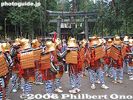
The warriors are the procession's main attraction.Waiting near Futarasan Shrine's torii.
|
|

Oda Nobunaga 織田信長
|
|

Ishida Mitsunari 石田三成
|
|
|

Toyotomi Hideyoshi 豊臣秀吉
|
|

Ii Naomasa 井伊 直政
|
|

Hello horse! He was just starting at me. Tokugawa Ieyasu
|
|

Tokugawa Ieyasu takes up residence in Edo. 徳川家康 江戸入府
|
|
|

Lord Ii Naomasa, a right-hand man of Tokugawa Ieyasu and major ally in the Battle of Sekigahara in 1600. Based in Hikone, Shiga Prefecture. 井伊直政 徳川家康 江戸入府
|
|

Year 1603: Tokugawa Ieyasu becomes Shogun. He designates Asakusa Temple as a place of worship, and he worships there himself in 1616. Behind him is his son Tokugawa Hidetada who became the second Tokugawa shogun. 徳川家康 江戸入府
|
|

Warrior armor displayed on second floor of Himeji Castle tower
|
|
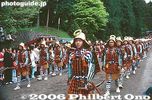
Warriors coming down the Omotesando. 武者行列
|
|

Face of a samurai.
|
|
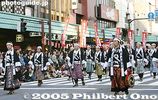
On Dec. 14, 1702, Asano's 47 masterless retainers avenged their master's death by attacking and beheading Kira at his residence in Ryogoku.義士の討ち入り
|
|
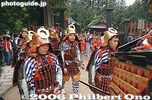
Warriors leaving the Otabisho.
|
|
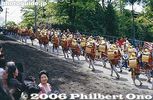
Warriors walk back up the slope in front of the Otabisho.
|
|
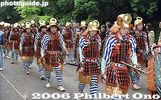
Warriors on Omotesando
|
|

Shinsengumi disbanded when the shogunate collapsed and Emperor Meiji became the head of state. The Shinsegumi wore a distinct costume with a light blue haori. 新撰組
|
|

Shinsengumi新撰組
|
|

Sign near Bannaji temple saying that the warrior procession would start at 7 pm.
|
|

On the way to Bannaji temple, this statue of the Ashikaga lord.
|
|

Gate to Bannaji temple. It is actually an arched bridge.
|
|

Gate to Bannaji temple.
|
|

Behind the gate to Bannaji temple.
|
|

After going through the gate, there's this path to the temple hall. Now lined with food stalls during the festival.
|
|

Plum trees
|
|

Bannaji temple main hall. National Treasure built by Ashikaga Takauji's father. A rare example of a main temple hall from the Kamakura Period.
|
|

Carrying wooden boxes of beans.
|
|

At one point along the procession route (a major road), there was a rest station where they served free ama-zake (sweet sake). The hot drink warmed us up.
|
|

On Feb. 3, the Yoroi Toshikoshi Shuko festival is held in the evening with a warrior procession going to Bannaji. Start of the warrior procession consisting of local children, men, and women. The procession started at Orihime Kominkan. 織姫公民館
|
|

Since it is held at night in the middle of winter, dress warmly.
|
|
|

Going over the arched bridge at Bannaji temple.
|
|
|
|
|
|
|
|
|

Yoroi Toshikoshi Shuko festival, Ashikaga, Tochigi.
|
|
|
|

Once in a while, they would shout a war cry.
|
|
|
|
|
|
|
|

Yoroi Toshikoshi Shuko festival, Ashikaga, Tochigi.
|
|
|
|
|
|
|
|
|
|
|
|
|
|
|

I saw at least two foreigners also dressed up as well.
|
|
|
|
|
|

Yoroi Toshikoshi Shuko festival, Ashikaga, Tochigi.
|
|

They all entered Bannaji temple by crossing the narrow arched bridge.
|
|
|
|
|
|
|

Within the grounds of Bannaji temple, they all gathered at this small outdoor stage.
|
|

After a few speeches, they got boxes of beans and threw them at us, but only the people up front got hit with beans.
|
|

The bean throwing was very short, both time-wise and distance-wise.
|
|
|
|
|
|

The bean-throwing was disappointing at Yoroi Toshikoshi Shuko festival in Ashikaga, Tochigi. Few beans and they hardly reached anybody.
|
|

Japan's oldest school.
|
|
|

Little Edo Hikone Castle Festival Parade
|
|

Ii clan warriors
|
|

Ii Naomasa (井伊直政) (1561-1602 ) was the first lord of Hikone from 1600. He was a general under Tokugawa Ieyasu whom he helped to win the Battle of Sekigahara in 1600. He was rewarded with the fief of Omi (now Shiga) and built Hikone Castle.
|
|
|

Hiko-nyan is Hikone's official mascot. A white cat wearing a samurai helmet modeled after Ii Naomasa.
|
|

Held annually on Nov. 3, a national holiday (Culture Day), the Hakone Daimyo Gyoretsu Procession starts at Yumoto Elementary School at 10 am. About 170 people dressed in feudal-era costume are in the procession. 湯本小学校
|
|
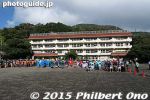
Yumoto Elementary School is where the procession started at 10 am. The procession route is quite long, about 6 km. The procession ends at 2:30 pm. 湯本小学校
|
|
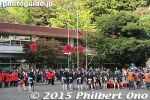
They had a short ceremony and briefing.
|
|
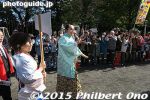
Special guest was former Yokozuna Wakanohana aka Hanada Masaru acting as the daimyo lord. Every year, they have a celebrity as the daimyo.
|
|
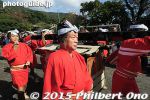
The procession reenacts the daimyo procession of Okubo Tadazane (Kaga no Kami), lord of Odawara on his way to Edo (Tokyo) for the periodic sankin kotai procession.
|
|
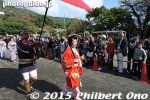
Daimyo's wife
|
|
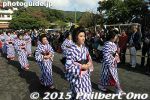
Ladies in waiting.
|
|
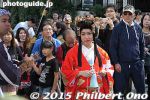
Daimyo's wife is one of the main characters in the procession.
|
|
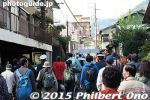
The crowd follows Hanada Masaru.
|
|
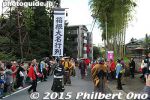
The Hakone Daimyo Gyoretsu Procession started in 1935 on the occasion of the Yumoto Expo. Except for the war years in the 1940s, this festival has been held annually.
|
|
|
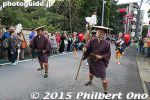
You hear, "Shitaaaa-niii, shitaaaa-niiii" (Go down, go down!) by the tsuyu-harai dew sweepers who lead the way to tell people to clear the way and bow in respect. 下ニー 下ニー
|
|
|

These men are the luggage carriers carrying the hasami-bako boxes containing clothing and other necessities. Hakone Daimyo Gyoretsu. 挟み箱
|
|
|
|
|
|
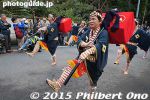
Hakone Daimyo Gyoretsu Procession on Nov. 3
|
|
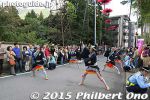
These are honor guards who carry feather-topped keyari poles and toss them to each other. In the old days, they did this when entering the lodging town. 毛槍
|
|
|
|
|
|
|
|
|

Lead car
|
|
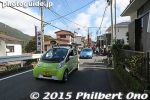
The procession is led by this guide car.
|
|
|
|
|
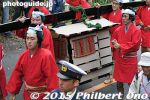
Daimyo's palanquin, however, I don't think anyone was in it. They never opened it.
|
|
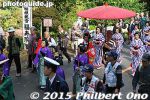
It's quite a long procession route so it's not that crowded much of the way.
|
|
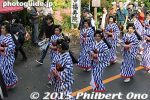
About 80 of the costumers are volunteers recruited from the general public. Women volunteers become ladies-in-waiting.
|
|
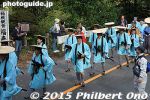
Foot soldiers. 徒士
|
|
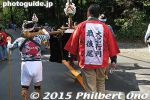
End of the procession.
|
|
|
|
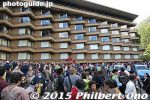
At about 11 am, they arrived at Hotel Nanpuso for a 30-min. break. ホテル南風荘
|
|
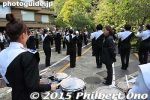
Band played during the lunch break.
|
|
|
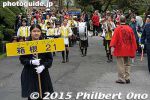
At around 11:30 am, the procession resumed. This is Marching Band Hakone 21. マーチングバンド箱根21
|
|
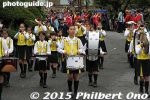
Marching Band Hakone 21. マーチングバンド箱根21
|
|
|
|
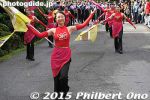
Marching Band Sirius
|
|

Marching Band Sirius マーチングバンド Sirius
|
|
|
|
|
|
|
|
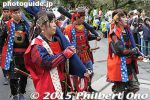
Matchlock gunners
|
|
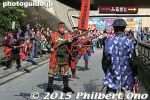
At 11:30 am in front of Hotel Okada, the Odawara Hojo Gunners fired matchlock guns. 小田原北條鉄砲衆 ホテルおかだ
|
|
|
|
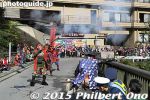
They fired twice.
|
|
|
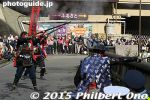
Very loud bang.
|
|
|
|
|
|
|
|
|
|
|
|
|
|
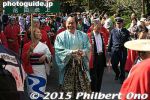
Hanada Masaru, former Yokozuna Wakanohana acting as the daimyo lord at Hakone Daimyo Gyoretsu
|
|
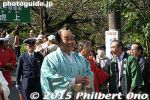
Hanada Masaru, former Yokozuna Wakanohana at Hakone Daimyo Gyoretsu
|
|
|
|
|
|
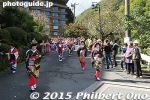
Hakone geisha
|
|
|
|
|
|
|
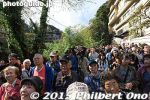
Narrow road
|
|
|
|
|
|
|
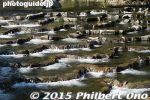
Scenic river
|
|
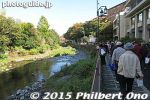
The procession took a lunch break at a hotel called Tenseien from noon to 1:20 pm. 天成園
|
|
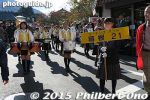
Walked to Chimoto Bridge near the entrance to the Hakone Yumoto. ちもと
|
|
|
|
|
|
|
|
|
|

Firing matchlock guns at Chimoto at 2 pm. 小田原北條鉄砲衆
|
|
|
|
|
|
|

Odawara matchlock gunners 小田原北條鉄砲衆
|
|
|
|
|
|
|
|
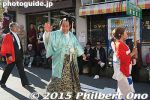
Hanada Masaru
|
|
|
|
|
|
|
|

Hakone geisha on rickshaw
|
|
|

Hakone geisha on rickshaw at Hakone Daimyo Gyoretsu
|
|
|
|
|
|
|

Kimono dancers at Hakone Daimyo Gyoretsu
|
|
|
|
|
|
|
|
|
|
|
|
|
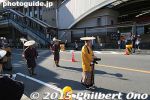
In front of Hakone Yumoto Station at about 2:10 pm.
|
|
|
|
|

Hanada Masaru
|
|
|
|
|
|
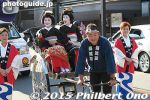
Hakone geisha on rickshaw
|
|
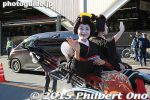
They even waved at the people in the train station.
|
|
|
|
|
|
|
|
|
|
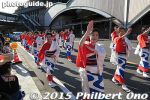
The procession crossed the Yumoto Ohashi Bridge and ended at 2:30 pm at Hakone Fujiya Hotel.
|
|
|
|
|

Statue of Lord Ii Naomasa (井伊 直政 1561-1602 ) in front of JR Hikone Station in 2007.
|
|
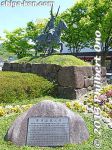
Statue of Lord Ii Naomasa (井伊 直政 1561-1602 ) in front of JR Hikone Station. One of the four great generals (徳川四天王) who helped Tokugawa Ieyasu win the Battle of Sekigahara (関ヶ原合戦) in 1600 to unify Japan and become shogun.
|
|
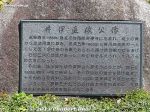
Ieyasu rewarded Naomasa with the strategic domain of Hikone (mainly Hikone, Maibara, Nagahama, Taga), making Naomasa the first Hikone daimyo (feudal lord 大名) in Omi Province (近江国).
|
|
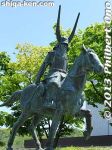
Sawayama Castle (佐和山城) came with the domain, but Naomasa did not like it, being outdated and the former castle of Ishida Mitsunari (石田 三成) who lost at Sekigahara.
|
|
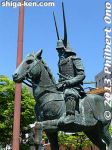
Naomasa planned to build a new castle, but died in 1602 from an old Sekigahara gunshot wound before construction began.
|
|

In front of Hikone Station, welcome banners for Hikone Castle's 400th anniversary in 2007 surround a statue of Ii Naomasa.
|
|
|
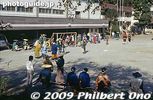
The following pictures were taken in an earlier year (not 2009). Hakone Daimyo Gyoretsu Procession starts at Yumoto Elementary School at 10 am. 湯本小学校
|
|

The procession reenacts the daimyo procession of Okubo Kaga, lord of Odawara on his way to Edo (Tokyo) for the periodic sankin kotai procession.
|
|

Ladies in waiting. These pictures were taken some time ago (not in 2009). Since I saw it, the procession has gotten larger with more groups.
|
|
|
|
|
|
|
|
|
|